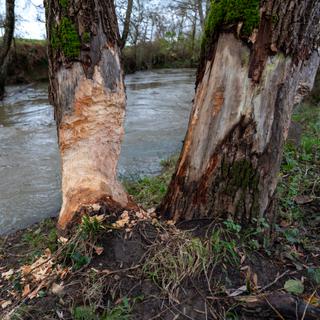


The beaver, a sometimes annoying yet very useful neighbor, is back in France
InvestigationVirtually extinct at the beginning of the 20th century, Europe's largest rodent is now well established along French waterways. Its presence, which can give rise to conflicts of use, also significantly benefits biodiversity and society.
For some, "it smells like bitumen," for another it brings to mind the "the big felt-tip pens" used on whiteboards. One by one, the 20 or so people seated in the village hall in Velles (Indre) held their noses over a bottle containing castoreum, a substance secreted by Europe's largest rodent. Once widely used to make perfumes, beavers use it to mark their territory.
For those tasked with documenting the beaver's presence in the countryside, it can also be a valuable clue – in addition to branches gnawed into the shape of a whistle or hourglass-shaped trunks. At the end of November, the French Biodiversity Office (OFB) invited members of nature protection associations and "river technicians" from the departmental council and a mixed development syndicate, as part of the opening of its "beaver network." "The aim of this day is to provide you with knowledge and to explain the missions in which you are invited to participate, particularly in terms of monitoring the species," explained Paul Hurel, the OFB's national network coordinator, who led the training course.
The official opening of the network is part of a wider dynamic: 50 years after the reintroduction of beavers into the Loire River, a symposium dedicated to the animal was held in Blois on Thursday, December 12 and Friday, December 13 – the culmination of a "year of the beaver." The main strands of the first national strategy dedicated to the mammal were due to be presented to attendees. By 2026, it could lead to a national action plan, endorsed by the government.
Over 20,000 individuals
You have 79.7% of this article left to read. The rest is for subscribers only.
